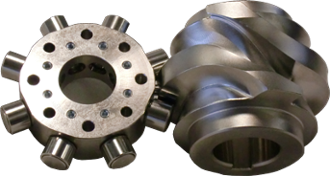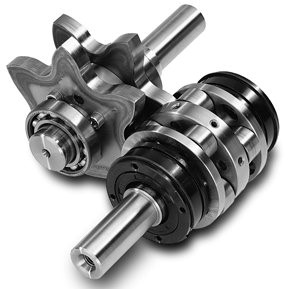Introduction to Rotary Index Tables
Rotary Index Tables have many applications in manufacturing including machining, assembly, inspection and welding. Indexing tables are positioning devices used to index parts in angular increments to be machined or assembled. They are application specific and are designed and manufactured to meet the needs of a specific operation or set of operations.
Rotary Index Tables have applications across a wide range of industries. From holding large weldments in aerospace, to positioning containers for label application in consumer goods manufacturing, to positioning medical products components for assembly processes. You can find rotary index tables somewhere in virtually every manufacturing industry.
All of our rotary indexers are cam driven. On small tables you have the choice of either a worm gear motor or helical bevel gear motor. Larger rotary index tables, a helical beven gear motor is most commonly used.
Rotary index tables are usually positioned along a vertical axis or can be mounted horizontally. When mounted horizontally there can be a tailstock to support the weight of longer work pieces between to ycenters.
Selecting a Rotary Index Table
There are important factors to consider when selecting a rotary index table. In principle, it may seem relatively simple to rotate a component and stop periodically at precise angles. In practice however, it can become a surprisingly difficult challenge to design and build machines that will do this precisely and reliably over the lifespan expected of modern manufacturing machinery.
The number one factor when rotating mass is determining the mass moment of inertia. This is often times overlooked when sizing a rotary device for applications. Once mass moment of inertia is known, a rotary index table can be sized correctly for whatever speed needs to be achieved.
Another important aspect is the size of the piece being moved, how big is it and how heavy is it? Size is an obvious constraint as you need a rotary index table that’s large enough for the piece intended. In order for a rotary index table to operately effectively and not cause internal damage, it needs to accelerate and decelerate at proper speeds.
A third factor is precision. There are some applications such as rotating a large component to allow welding features on it where the individual stop positions can be fairly loose, such as say within +/- ¼” and other applications where repeatable positioning within thousands of an inch is necessary.
When selecting a rotary index table then, it’s important to be able to specify the following:
- – Accuracy
- – Backlash
- – Mass Moment of Inertia
- – Acceleration and Deceleration
- – Speed
- – Environment
To learn more about specifying a rotary table, you can get our guide here.
Types of Cam Indexers and Applications
Servo Driven Gear Head vs. Programmable Index Drives for Horizontal Rotary Index Table Applications
Many rotary index table end users need the flexibility afforded by having a fully programmable tool. A seemingly simple way to achieve this is by using a gear head coupled to a servo motor or an AC motor with an encoder. In reality though, while this seems simple and cost-effective, because of the physics described above, high inertia, combined with a goal of high accuracy can create a problematic mis-match.
To understand when you should be considering a cam indexer instead,
read about the differences here.
Servo Driven Barrel-Cam Rotary Index Table
With a servo-driven barrel cam rotary index table, it’s possible to deliver a wide range of table sizes, with zero backlash and unparalleled accuracy. Servo driven rotary indexers allow heavy inertial loads to be rotated in a very smooth and controlled manner.
You can learn more
about this type of rotary index table here.
Cam-Driven Indexing Rotary Index Table
Cam-driven rotary index tables can have significant advantages over other types of rotary index table drive systems such as gear drives. Cam-driven rotary index tables provide extremely high accuracy because they operate with no backlash. There are several types of commonly used cam-driven rotary index table systems, each is best for a specific application.
Barrel Cam-Driven Rotary Index Table Drive
Barrel cams represent strength in indexing. Primarily found in rotary index tables, indexers utilizing barrel cams feature the greatest strength /size offering available.
To watch a barrel dam in
action, see the
video here.
Barrel Cam Rotary Index Table Drive
Flat / Disc Cam-Driven Rotary Index Table Drive
Flat, or disc, cams are valuable for their space-saving attributes and the potential to produce very long dwell periods and operate at high speed.
To watch
a flat cam drive in action, see the video here.
Flat / Disc Rotary Table Drive
Globoidal Cam-Driven Rotary Index Table Drive
Globoidal cams are similar to barrel cams in shape (and come from the same steel stock), but have considerably different profiles. Tapered walls in the grooves are designed to accommodate cam followers fixed to an output shaft in a “star” configuration.
To watch
a globoidal campaign in action, see the video
here.

Fixed and Flexible Rotary Indexing Tables
Cam driven rotary table indexers are sometimes call ‘fixed indexers’. With a fixed indexer, the cam drives receive constant power input from the motor. This rotates the cam which then rotates the output. Based upon the design of the drive, the output will have ‘dwell’ periods (when the output is stopped) as well as acceleration, deceleration and peak velocity. Cam-driven rotary index tables have a number of advantages, however, they won’t meet the needs of every application.
Rotary index tables can also be ‘flexible’. Flexible rotary index tables use a cam that has a constant lead, that is the output is at a constant velocity if the motor is running at a constant velocity. Constant lead cams provide a high-precision mechanical transition of power to the output and since acceleration and deceleration are still necessary, the logic controller for the index tables motor provides the necessary control.
Rotary Index Table Machine Components & Options
Rotary Index tables can be configured in a near infinite number of ways to meet the needs of specific applications.
Common components / accessories that we are asked to provide include:
features
- Machine Bases
- Slip Rings / Rotary Unions
- Top Dials
- Tooling Frames
- Controls
- Robot Integration
- Custom Coatings
- Motors and Reducers
- Trunnion Riser Weldments
- Mechanical Safety Lockouts
- Explosion proof drive systems
For a more in depth review of these components, you can read here
Rotary Index Table Commissioning
Getting to a reliable and productive rotary index table installation requires careful application engineering, component selection and integration, customization to meet specific factors such as the operating environment and proper commissioning. It’s important that you discuss commissioning with your rotary index table provider so that you meet the intended functionality and reliability and so that there are no excuses when it comes to any troubleshooting that may occur.
Your manufacturer should offer trained service technicians who are capable of complete testing of both the rotary tables and control systems including loading, parameters and tuning. Your best option is often to have a pre-programmed VFD panel which can significantly reduce your risk when going through commissioning and start-up.
You can
learn more about VFD Control Panels and Rotary Index Table Commissioning here.
Rotary Index Table Maintenance
The number one cause for rotary index table failure is stopping out of position due to lack of maintenance. Every rotary index table should have a regular health assessment.
To learn more about a proper rotary index table health assessment, you can learn more here.
You may find the Motion Index Drives – Rotary
Index Table Troubleshooting Guide to be useful. You can access that here.
If you need any
technical or service
assistance please contact us
for 24 hour support
Selecting a Rotary Index Table Manufacturer
Rotary index tables are often critical parts of manufacturing workflows. Rotary index tables that can’t deliver on precision, production scale, reliability and longevity can be costly to both the company and the specifying engineer.
That’s why it’s important that you select a partner with a proven track record of delivering the right machine for the application, producing machinery using the highest quality components and being there to have your back should things not go as you planned.
Features that can be important in your rotary index table include:
- Low friction internal components. Lower friction index drives can require as little as one-third the amperage to operate while producing greater torque.
- Flame-hardened cams and cam followers. Flame-hardened cams and cam followers can withstand forces that cause less robust components to prematurely fail.
It goes without saying that your rotary index drive partner
should be ISO 9001 Certified and embrace a culture of continuous improvement. To learn a bit about what we feel makes Motion Index Drives a uniquely valuable rotary index table partner, you can explore here!

 Translate
Translate
